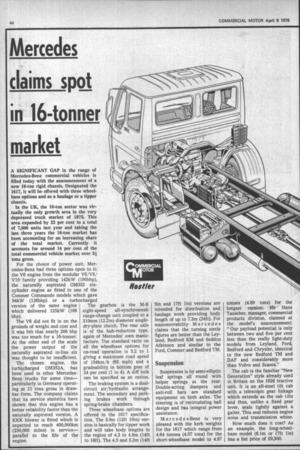Mercedes claims spot in 16-tonner market
Page 46

If you've noticed an error in this article please click here to report it so we can fix it.
A SIGNIFICANT GAP in the range of Mercedes-Benz commercial vehicles is filled today with the announcement of a new 16-ton rigid chassis. Designated the 1617, it will be offered with three wheelbase options and as a haulage or a tipper chassis.
In the UK, the 16-ton sector was virtually the only growth area in the very depressed truck market of 1975. This area expanded by 22 per cent to a total of 7,800 units last year and taking the last three years the 16-ton market has been accounting for an increasing share of the total market. Currently it accounts for around 14 per cent of the total commercial vehicle market over 31 tons gross.
For the choice of power unit, Mercedes-Benz had three options open to it: the V6 engine from the modular V6/V8„' VIO family providing 142kW (190bhp), the naturally aspirated 0M352 sixcylinder engine as fitted to one of the Commer Commando models which gave 94kW (126bhp) or a turbocharged version of the same engine which delivered 125kW (168 bhp).
The V6 did not fit in on the groUnds of weight and cost and it was felt that nearly 200 bhp was too much for a 16-tonner. At the other end of the scale the power output of the naturally aspirated in-line six was thought to be insufficient.
The chosen engine, the turbocharged 0M352A, has been used in other MercedesBenz trucks for some time-particularly in Germany operating at 21 tons gross in drawbar form. The company claims that its service statistics have shown that this engine has a better reliability factor than the naturally aspirated version. A KKK blower is fitted which is expected to reach 400,000km (250,000 miles) in service— parallel to the life of the engine. The gearbox is the M-B eight-speed all-synchromesh range-change unit coupled to a 310mm (12.2in) diameter singledry-plate clutch. The rear axle is of the hub-reduction type, again of Mercedes' own manufacture. The standard ratio on all the wheelbase options for on-road operation is 5.2 to 1 giving a maximum road speed of 104km/h (65 mph) and a gradeability in bottom gear of 24 per cent (1 in 4). A diff lock can be specified as an option.
The braking system is a dualcircuit air/hydraulic arrangement. The secondary and parking brakes work through spring-brake chambers.
Three wheelbase options are offered in the 1617 specification. The 3.9m (12ft 10in) version is basically for tipper work and will take body lengths in the region of 4.3 to 4.9m (14ft to 16ft). The 4.5 and 5.2m (14ft 9in and 17ft fin) versions are intended for distribution and haulage work providing body length of up to 7.3m (24ft). For manoeuvrability Mercedes claims that the turning circle figures are better than the Leyland, Bedford KM and Seddon Atkinson and similar to the Ford, Commer and Bedford TM.
Suspension Suspension is by semi-elliptic leaf springs all round with helper springs at the rear. Double-acting dampers and anti-roll bars are standard equipment on both axles. The steering is of recirculating ball design and has integral power assistance.
Mercedes-Benz is very pleased with the kerb weights for the 1617 which range from 4.64 tonnes (4.57 tons) for the short-wheelbase model to 4.97 tonnes (4.89 tons) for the longest version. Mr Hans Tauscher, manager, commercial products division, claimed at the model's announcement: "Our payload potential is only between two and five per cent less than the really light-duty models from Leyland, Ford, Bedford and Chrysler, identical to the new Bedford TM and DAF and considerably more than Volvo and Scania."
The cab is the familiar "New Generation" style already used in Britain on the 1626 tractive unit. It is an all-steel tilt cab with a telescopic gear linkage which extends as the cab tilts and thus, unlike a fixed gear lever, seals tightly against a gaiter. This seal reduces engine noise and transmission whine.
How much does it cost? As an example, the long-wheelbase model (8.1m or 17ft lin) has a list price of £9,300.




























































































































